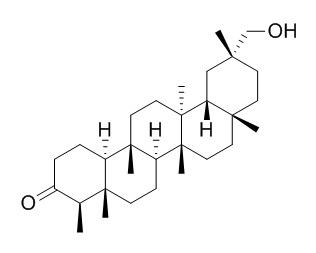29-Hydroxyfriedelan-3-one
Reference standards.
Inquire / Order:
manager@chemfaces.com
Technical Inquiries:
service@chemfaces.com
Tel:
+86-27-84237783
Fax:
+86-27-84254680
Address:
1 Building, No. 83, CheCheng Rd., Wuhan Economic and Technological Development Zone, Wuhan, Hubei 430056, PRC
Providing storage is as stated on the product vial and the vial is kept tightly sealed, the product can be stored for up to
24 months(2-8C).
Wherever possible, you should prepare and use solutions on the same day. However, if you need to make up stock solutions in advance, we recommend that you store the solution as aliquots in tightly sealed vials at -20C. Generally, these will be useable for up to two weeks. Before use, and prior to opening the vial we recommend that you allow your product to equilibrate to room temperature for at least 1 hour.
Need more advice on solubility, usage and handling? Please email to: service@chemfaces.com
The packaging of the product may have turned upside down during transportation, resulting in the natural compounds adhering to the neck or cap of the vial. take the vial out of its packaging and gently shake to let the compounds fall to the bottom of the vial. for liquid products, centrifuge at 200-500 RPM to gather the liquid at the bottom of the vial. try to avoid loss or contamination during handling.
Applied Biological Chemistry2023, 66(58):112.
Chinese Journal of Tissue Engineering Research2024, 28(8):1149-1154.
Journal of Herbal Medicine2024, 48:100950
Hong Kong Baptist University2023, 048330T.
Nutrients2022, 14(14)2929
Food Res Int.2018, 106:909-919
Kor. J. Pharmacogn.2016, 47(1):62-72
Molecules2022, 27(11):3606.
Toxicol In Vitro.2022, 81:105346.
Korea Institute of Oriental Medicine2020, doi: 10.21203.
Related and Featured Products
Planta Med. 2001 Feb;67(1):65-9.
Isolation and frontier molecular orbital investigation of bioactive quinone-methide triterpenoids from the bark of Salacia petenensis.[Pubmed:
11270725]
METHODS AND RESULTS:
The crude dichloromethane bark extract of Salacia petenensis (Hippocrateaceae) from Monteverde, Costa Rica, shows antibacterial and cytotoxic activity. Bioactivity-directed separation led to the isolation of tingenone and netzahualcoyonol as the biologically active materials. Also isolated from the extract were 3-methoxyfriedel-2-en-1-one (a new natural product) and 29-Hydroxyfriedelan-3-one. The structures of these compounds were elucidated on the basis of NMR spectral analysis. Molecular orbital calculations have been carried out using the semi-empirical PM3 and Hartee-Fock 3-21G ab initio techniques on the quinone-methide nortriterpenoids tingenone and netzahualcoyonol, as well as on the nucleotide bases adenine, guanine, cytosine, and thymine.
CONCLUSIONS:
The molecular orbital calculations suggest that a possible mode of cytotoxic action of quinone-methide triterpenoids involves quasi-intercalative interaction of the compounds with DNA followed by nucleophilic addition of the DNA base to carbon-6 of the triterpenoid.
Phytochemistry,1984,23(3):631-3.
The chemistry of toxic principles from Maytenus nemerosa[Reference:
WebLink]
METHODS AND RESULTS:
Maytenus nemerosa has been fractionated systematically by following the toxicity of extracts, partitioned solutions and column chromatographic fractions against cultured KB cells. Several compounds were isolated in this fashion, including 3-oxo-20(29)-lupen-30-al, β-amyrin, 29-Hydroxyfriedelan-3-one, 30-hydroxy-20(29)-lupen-3-one, 30-hydroxyfriedelan-3-one and lup-20(29)-ene-3β,30-diol, as well as tingenone, 20-hydroxytingenone and galactitol.
CONCLUSIONS:
3-Oxo-20(29)-lupen-30-al was shown to be cytotoxic for the first time; the structural basis of this cytotoxicity was investigated, in part, by bioassay of four products obtained by chemical transformation of single, isolated principles.



